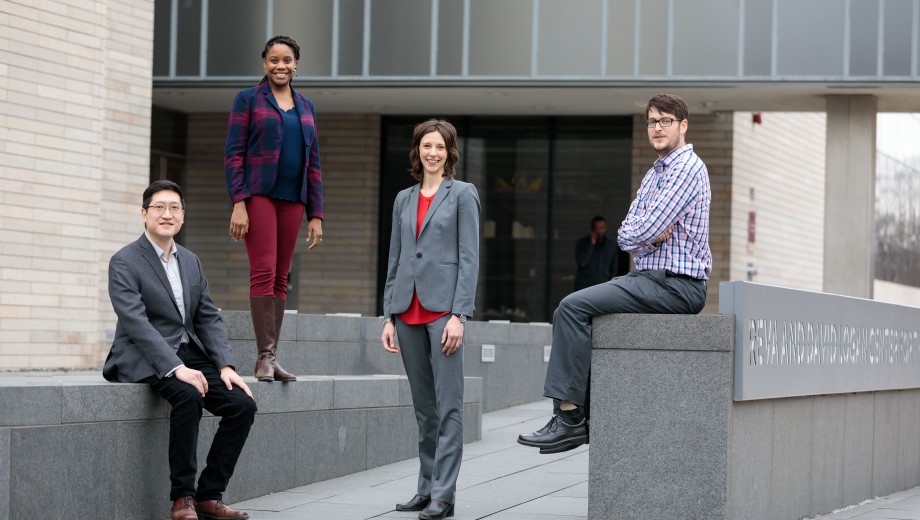The University’s Department of Music has long been a leader in music history, music theory, and ethnomusicology, along with composition. In recent years, as the department has expanded its programs in music theory and ethnomusicology and launched the Chicago Center for Contemporary Composition, it has continued to develop a richly collaborative culture. “Inasmuch as there is sub-disciplinary diversification,” says department chair Berthold Hoeckner, “there’s also a strong integration that is unique to Chicago.”
This sense of unity in diversity is reflected in the department’s junior faculty: two composers, an ethnomusicologist, and a music theorist with a strong historical bent.
The composers
Assistant professor Sam Pluta works on the cutting edge of electronic music, a journey that began in the late 1990s when one of his instructors at Santa Clara University put him in a room with Pro Tools software. The digital audio workstation held no apparent interest to his teacher or fellow students, so the instructor told him, “You figure it out.”
Pluta did figure it out, developing his own electronic music software and becoming adept at wielding the laptop as a live performance instrument that complements, interprets, and transforms the sounds of acoustic instruments on stage. Pluta has toured internationally with Rocket Science, the Evan Parker Electro-Acoustic Ensemble, and the Peter Evans Quintet, and since 2009 has been technical director and composing member of the new music collaborative Wet Ink Ensemble.
At UChicago, Pluta directs the Chicago Integrated Media Experimental (CHIME) Studio, where he also teaches classes in electronic composing and sound design. “My work,” he says, “is to set up a studio where students can come in and achieve their dreams.”
While assistant professor Anthony Cheung sometimes ventures into electronic music as well, he writes mainly for acoustic instruments. Incorporating a range of jazz and classical influences, Cheung’s music is primarily notated but channels some of jazz improvisation’s rhythmic and harmonic syntax. Cheung’s work has been widely programmed and performed internationally, including commissions by the Ensemble Modern, Ensemble Intercontemporain, New York Philharmonic, Frankfurt Radio Symphony Orchestra, and Scharoun Ensemble Berlin.
Cheung was also a founding member of Talea Ensemble, now a staple of the New York contemporary music scene, serving as its pianist and artistic director from 2007 to 2017. Talea Ensemble performs on Cheung’s latest release, Dystemporal (Wergo, 2016), which showcases pieces he wrote over seven years.
The ethnomusicologist
Assistant professor Jessica Swanston Baker’s current book project, “Too Fast: Music, Coloniality, and Time in St. Kitts and Nevis,” is an examination of speech as performance in the small-island Caribbean. Contextualizing speech acts within four centuries of colonization, Baker explores the way people talk about music, sound, and musicianship in the twin-island nation in the Eastern Carribean’s Leeward archipelago.
Speech in the Caribbean contains multiple layers of meaning that are rooted in a complex local history. Baker notes, for instance, that when a Kittitian local decries the popular carnival music known as “wilders” as “too fast,” the remark functions simultaneously as a comment on the frenetic tempo, a judgment about suggestive dancing, and a declaration of bewilderment about the state of music production and consumption. Those who prize a “long-simmered approach” to musicianship, Baker says, are uncomfortable about the fact that we can now program beats on our phones.
The music theorist
Assistant professor Jennifer Iverson, a music theorist and historian, is examining the cultural significance of electronic music after World War II. For her book, Electronic Inspirations: Technologies of the Cold War Musical Avant-Garde (forthcoming from Oxford University Press), she focuses on a studio in the WDR radio station in Cologne, West Germany. Composers and technicians worked closely together in the studio, repurposing wartime innovations such as cryptographical theory and magnetic tape with the aim of creating new worlds of sound unfettered by traditional instruments and movements—an avant-garde response to the classical sensibilities of both right- and left-wing totalitarian regimes.
Iverson demonstrates how the new genre challenged established ideas about artistic production. “The earliest piece produced at this studio,” Iverson was thrilled to discover, “was never premiered,” at least not in its original form. Created by a technician but later spliced and cannibalized in works claimed by the composers, the studio’s “Piece Zero” is emblematic of its laboratory-style collaboration, which refuted traditional notions of the artist as solitary genius.
A productive synthesis
Cheung notes that the faculty “have a very healthy balance and genuine interest in each other’s work.” They also collaborate, as in the two-day symposium this past March on the work of twentieth-century composer György Ligeti that was co-organized by Cheung, Pluta, Iverson, and associate professor Seth Brodsky. Appropriately, Ligeti himself—a subject of Cheung’s and Iverson’s research—was an eclectic composer known for bringing together disparate traditions.

